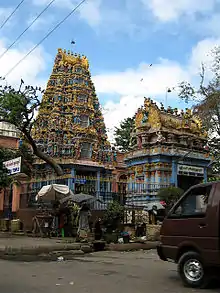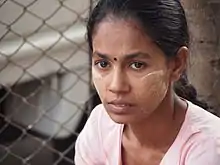Burmese Indians
Burmese Indians are a group of people of Indian origin who live in Myanmar (Burma). The term 'Burmese Indian' refers to a broad range of ethnic groups from India, most notably from present-day South Asian countries such as Bangladesh, India and also Pakistan. While Indians have lived in Burma for many centuries, most of the ancestors of the current Burmese Indian community emigrated to Burma from the start of British rule in the mid-19th century to the separation of British Burma from British India in 1937. During colonial times, ethnic Indians formed the backbone of the government and economy serving as soldiers, civil servants, merchants, moneylenders, mobile laborers and dock workers. A series of anti-Indian riots in the 1930s and mass emigration at the onset of the Japanese invasion of Burma in 1942 were followed in the 1960s by the forced migration of hundreds of thousands of ethnic Indians, exacerbated by internal conflict in Myanmar.[1]
| Total population | |
|---|---|
| 950,000 - 1,030,000 1.7% to 1.9% of the Burmese population | |
| Regions with significant populations | |
| Yangon, Mandalay | |
| Languages | |
| Burmese, Tamil (majority), Bengali, Urdu, Telugu, Gujarati, Odia, Hindi, Punjabi | |
| Religion | |
| Majority: Hinduism (with significant influences from Buddhism) Minority: Islam · Christianity · Sikhism · Buddhism | |
| Related ethnic groups | |
| Non-resident Indian and person of Indian origin |
Ethnic Indians today are estimated to account for approximately 2% (about 950,000) of the population of Burma and are concentrated largely in the two major cities (Yangon and Mandalay) and former colonial towns (Pyin U Lwin and Kalaw). Burmese Indians wield considerable influence and control over the Burmese economy and have a major socio-cultural presence within the country.[2][3] Amongst the well-known Burmese Indians is S N Goenka, a leading practitioner and teacher of vipassanā meditation and Helen, a well-known Bollywood film actress who is also of Anglo-Burmese descent.
Etymology
In the Burmese language, Indians are typically called kalar (ကုလား, spelt kula:). The origins of the term itself are disputed. The Myanmar Language Commission officially traces the etymology of the word kalar to the Pali term kula (ကုလ), which means "noble," "noble race", or "pure."[4][5] Folk etymology ascribes the origins of this term to a calque of two Burmese words: ကူး+ လာ (lit. "to cross over [from the sea]"), although this etymology has no scholarly basis.[6][7] The term kalar also phonetically resembles the word for "black" in several Indic languages, including Hindi and Urdu (cf. Sanskrit kāla), and is used by Indians as an ethnic slur for dark-skinned people and Africans.[8]
The Burmese language term kalar has been borrowed into a number of regional languages, including Shan (ၵလႃး, kala),[9] Mon (ဂလာ, h'lea),[10] S'gaw Karen (kola),[6] and Khmer (កុឡា, kola). The Khmer term kola refers to the Kula people, a diverse community of migrants from present-day Shan State.
The term kalar has a long history; it is attested in Pagan Kingdom stone inscriptions dating to the 1100s, and was the name of a prominent 17th century Burmese historian, U Kala.[6] During the pre-colonial era, Westerners, including those from the Indian subcontinent, the Middle East, and Europe, were collectively known as kalar, an exonym used by Burmese speakers.[11][7] For instance, kalaphyu (ကုလားဖြူ, lit. 'white kalar') or bayinngyi kalar (ဘရင်ဂျီကုလား, lit. 'Frank kalar') were used as Burmese exonyms for Europeans.[11] To this day, the word kalar features in many Burmese compound words, including kalahtaing (ကုလားထိုင်, lit. 'kalar seat' or 'chair') and kala be (ကုလားပဲ, lit. 'kalar bean' or 'chickpea')"[11] By 1886, the conventional use of kalar in reference to a "native of continental India" was documented in dictionaries.[7] Burma was administered as a part of British India for the majority of its time under British occupation between 1826 and 1948. Colonial exploitation during British Burma engendered nationalist and anti-Indian sentiment among locals, which was reinforced in the use of kalar as an exonym with negative connotations.[7] The term kalar is now considered pejorative by some members of the Burmese Indian community.[12]
History
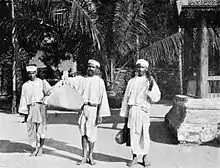
Indian immigration
Before the British conquest, the Indians in Lower Burma primarily engaged in trade. The small Indian community was located almost wholly in Rangoon during Konbaung and preceding eras. After 1852, they migrated to Lower Burma because of the jobs available in the expanding economy and the new provincial bureaucracy of the British Raj. Their population rapidly rose from 37,000 in 1871 in Lower Burma to 297,000 in 1901 with 86% being born outside Burma by that year. Most Indians were from Madras Presidency and Bengal Presidency. Over 60% in the last decades of 19th century were from Madras. 30% were from Bengal in 1881 and 25% in 1901.[13]
There were no effective curbs on Indian immigration until the eve of World War II despite the implementation of the Government of Burma Act. By 1931, there were more than one million Indians in Burma, about 7% of the population, and were mostly concentrated in Lower Burma.[14] The census of 1931 enumerated 1,017,825 Indians in Burma with 617,521 born in India.[15] Per the census of 1931, the total population of Rangoon was 400,415 out of which comprised 212,929 Indians. They comprised 2.5% of population in Upper Burma and 10.9% in Lower Burma.[16]
The majority of Indians arrived in Burma whilst it was part of British India. Starting with the annexation of Tenasserim and Western Burma after the First Anglo-Burmese War, a steady stream of Indians moved to Burma as civil servants, engineers, river pilots, soldiers, indentured labourers, and traders.[17] Following the annexation of Upper Burma in 1885, numerous infrastructure projects started by the British colonial government and increases in rice cultivation in the delta region caused an unprecedented economic boom in Burma that drew many Indians, particularly from southern India, to the Irrawaddy Delta region.[18]
Anti-Indian sentiments
After the First World War, anti-Indian sentiments began to rise[19] for a number of reasons. The number of ethnic Indians was growing rapidly (almost half of Yangon's population was Indian by the Second World War[20]). Indians played a prominent role in the British administration and became the target of Burmese nationalists.[17] Racial animosity toward Indians because of their skin-colour and appearance also played a role. Meanwhile, the price of rice plummeted during the economic depression of the 1930s and the Chettiar from South India, who were prominent moneylenders in the rice belt, began to foreclose on land held by native Burmese.[17][21]
In May 1930, a British firm of stevedores at the port of Rangoon employed Burmese workers in an attempt to break a strike organised by its Indian workers. When, on 26 May, the strike ended and the Indians returned to work, clashes developed between the returning Indian workers and the Burmese workers who had replaced them. The clashes soon escalated into large-scale anti-Hindu riots in the city. Over 200 Indians were killed and their bodies flung into the river. Authorities ordered the police to fire upon any assembly of five or more who refused to lay down their arms, under Section 144 of the Criminal Procedure Code. Within two days the riot spread throughout the country to locations such as Maymyo.[22]
The Second World War and after
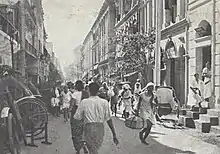
At the start of World War II, almost half of Rangoon's (modern-day Yangon) population was Indian,[20] and about 16% of the population of Burma was ethnically Indian.[23] As a consequence of the Japanese invasion of 1942, half a million members of the Indian community fled Burma overland into Assam, largely on foot. The refugees suffered terribly and thousands died. Some of the Indian community remained in Burma during the war; others returned after the war, although many never did.[21] After independence, Burmese law treated a large percentage of the Indian community as 'resident aliens.' Though many had long ties to Burma or were born there, they were not considered citizens under the 1982 Burma citizenship law which restricted citizenship for groups immigrating before 1823.[24]
After he seized power through a military coup in 1962, General Ne Win ordered a large-scale expulsion of Indians. Although many Indians had been living in Burma for generations and had integrated into Burmese society, they became a target for discrimination and oppression by the junta. This, along with a wholesale nationalisation of private ventures in 1964, led to the emigration of over 300,000 ethnic Indians from Burma.[21] Indian-owned businesses as well as Burmese businesses were nationalised due to the so-called "Burmese way to Socialism". Many Indians returned and were given 175 kyat for their trip to India. This caused a significant deterioration in Indian-Burmese relations and the Indian government arranged ferries and aircraft to lift Burmese of Indian ethnicity out of Burma.[25]
Culture
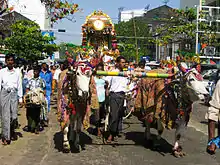
India has been particularly influential in Burmese culture as the cradle of Buddhism, and ancient Hindu traditions can still be seen in Brahmans presiding over important ceremonies such as weddings and ear-piercings but most notably in Thingyan, the Burmese New Year festival.[26] The Burmese poetry tradition of niti (notably the Dhammaniti) also has Indian origins.[27] Traditions of kingship including coronation ceremonies and formal royal titles as well as those of lawmaking were also Hindu in origin.[26] Many Burmese dishes and breads came as a result of Indian influence, prominently reflected in the Burmese version of Indian biryani.
Burmese Indians came from various groups from different parts of India, including Tamils, Telugus, Hindi speakers, Bengalis, Gujaratis, Oriya, and Punjabis. Today they form approximately 2% (about 950,000)[28] of the population, according to the CIA World Factbook 2006, although exact figures do not exist due to uncertainties over census results and methods in Myanmar. Disaffected young Indians often flee the cities and join ethnic resistance movements. The All Burma Muslim Union whose members consist largely of Muslims of Indian origin is routinely labelled by the government as "Muslim terrorist insurgents". It operates alongside the Karen National Union which has a militant wing and, despite a swelling of its ranks following anti-Muslim riots in the eighties, remains a very minor force.[29]
Religion
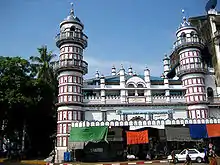
Burmese Indians practise Hinduism, Islam, Sikhism, Buddhism and Christianity. Burmese-Indian Hindus have good and peaceful relationships with the native Burmese. Burmese-Indian Muslims have the decades old ongoing conflict with the native Burmese.[30][31]
Predominantly, Burmese Indians are Hindu. The practice of Hinduism among Burmese Indians is also influenced by Buddhism. In addition of Hindu deities, the Buddha is also worshiped and many Hindu temples in Myanmar house statues of the Buddha.[32][33]
Burmese Muslims, some of them of mixed blood born of Burmese mothers and some of them with full Burmese blood, (ဗမာမူစလင်); with small numbers of Twelvers.[34] The Burmese call them Zaydabayi.
The constitution grants limited rights to freedom of religion; however, some articles in the constitution, as well as other laws and policies, restrict those rights. In practice the government enforced those restrictions.[35] "Muslims continue to experience the most severe forms of legal, economic, religious, educational, and social restrictions and discrimination".[36] The military dictatorship rejects or ignores their requests when they want to build mosques in the country or to go abroad for religious ceremonies.[18][29] Although there is limited freedom of religion in Burma, Muslims decided not to hold Eid al-Adha in 2012 due to Rakhine-Rohingya strikes in Rakhine State.
Language
Burmese Indians are from an array of ethnic backgrounds. There are Tamils from Tamil Nadu, Telugus from Andhra Pradesh and Marwaris from the Marwar region of India's Rajasthan state as well as Bengalis hailing from the Indian state of West Bengal as well as the present-day independent nation of Bangladesh. Prior to the expulsion of Indians, there were also Malayalis from Kerala, Odias from Odisha, Punjabis from the state of Punjab who are mostly Sikhs and two groups of Gujaratis, both Gujarati-speaking Parsis and Gujaratis proper who are mostly Hindus or Muslims by faith hailing from the state of Gujarat. All can and were able to communicate in Burmese due to years of assimilation and lack of education in languages other than English. Other languages used by Burmese Indians include Tamil, Telugu and small pockets of Malayalam speakers.
Economic role
Historically, Burmese Indians have made their livelihoods as merchants, traders and shopkeepers as well as manual labourers such as coolies, dockers, municipal workers, rickshaw men, pony cart drivers, malis and durwans. They were also heavily represented in certain professions such as civil servants, university lecturers, pharmacists, opticians, lawyers and doctors. They dominated several types of businesses such as auto parts and electrical goods, ironmongery and hardware, printing and bookbinding, books and stationery, paper and printing ink, tailoring and dry-cleaning, English tuition, and money lending. They traded in textiles, gold and jewellery, where the market was traditionally dominated by Burmese women. The Chettiars of Burma functioned as moneylenders and have been thought crucial in the growth in agricultural output of Burma during the colonial era.[37] Today, many Indians live in central Rangoon on both sides of the Su Lei Paya Road and are largely involved in businesses, including restaurants, jewellery shops and money exchanges.
Notable Burmese Indians and others

- Alan Basil de Lastic - (1929–2000) was the fourth Archbishop of Delhi. He was born in Maymyo of mixed Burmese, Irish and French ancestry.[38]
- Babu Lal Murarka, an Indian Freedom Fighter made Burma his home in 1952 and set up the largest private textile mills in Myanmar along with other investors. He proved the Indian industrial entrepreneurship to the Burmese government.
- Bahadur Shah Zafar, the last Mughal Emperor was exiled to Rangoon in British-controlled Burma, after the Indian Rebellion of 1857. He, along with his wife Zeenat Mahal and granddaughter Raunaq Zamani Begum, is buried at the Mazar (mausoleum) at No 6 Theatre Road in Yangon.[39]
- Bhanumati Devi, an Odia film and theatre actress who was born in Burma.[40]
- Captain Ohn Kyaw Myint, martyred after failed attempt of coup d'état[41]
- Chaudhry Charan Das, originally hailing from Gujranwala (now in Pakistan), Chaudhary Charan Das moved to Burma in the early 1900s to establish a soap factory in Mandalay (Burma) under the banner S Sagar & Co. Decades later during Japanese invasion the family then returned and settled in Rawalpindi. During India-Pakistan partition in 1947, the family eventually settled in Kapurthala (India) where Chaudhary Charan Das's eldest son Dr Shanti Sagar Verma soon established himself as a very prominent and successful doctor and where he opened one of the first private multi-speciality hospitals in the city.
- Daw Tint Tint Usha, the wife of former President of India, K R Narayanan. Usha Narayanan (1923–2008) worked on several social welfare programmes for women and children in India and had completed her Masters in Social Work from Delhi School of Social Work.[42] She also translated and published several Burmese short stories; a collection of translated stories by Thein Pe Myint, titled Sweet and Sour, appeared in 1998. She is the only woman of foreign origin to have become the First Lady.
- Dr B S Joshi (b. 4 March 1912 and d. 15 October 2009), Civil Surgeon in Burma Medical Services. Graduated Medical College Rangoon with Honours receiving the Bishop Bigandit Medal (1936). Married Dr Ratna Sundari Misra D/o Dr Matabadal Misra and she was one of the only female doctors in Burma. Together they had hospitals sanctioned and constructed throughout the districts of Burma. He was a friend to both General Ne Win and U Nu, a leading Nationalist and political figure of the Union of Burma.[21]
- Dr Maung Di, Department chair and dean of Rangoon Arts and Science University (now Yangon University), Deputy Education Minister. Son of the Dean of Islamic Religious College in Kanbalu.[41]
- Dr Nath (Tun Maung), a communist leader and founding member killed in the 1960s[21]
- Dr Ram Bax Singh, a Jat Sikh who served as the Port Health director for Port of Rangoon till early 1960.
- Dr Santosh Sureen (Shwe Mann), a Municipal Health Minister during the 1960s.
- H N Goshal (Thakin Ba Tin), a leader of Communist Party of Burma and founding member from the 1940s to the 1960s, killed in an internal purge in 1967. He was an ethnic Bengali.[21]
- Helen of Bollywood, born Helen Jairag Richardson Khan in Rangoon on 14 July 1938, she fled to India during World War II and became famous for playing the vamp in Indian cinema.
- Karim Ghani was born in Sodugudi, Ilayangudi, a politician in South-East Asia of Indian origin. Before the Second World War Karim Ghani was a parliamentary secretary in Burma under Dr Ba Maw.
- M A Rashid, a Government Minister in the 1950s[21]
- Parshuram Verma, a Freedom Fighter in Subhas Chandra Bose's Azad Hind Fauj in Myanmar, social worker and leader of repatriated Indian Burmese in Bihar & UP. He repatriated Indian Burmese to Bihar and Uttar Pradesh who were migrated from these areas to Myanmar at the time of British era and started migrating into India at the time of unrest during General Ne Win regime in 1969. He was involved in address their problems and find the solutions with the help of various Indian Government Ministries and Authorities.
- S Mukerjee aka Pyu Win, a communist trade union leader killed in the 1950s[21]
- S N Goenka, a vipassana meditation teacher (born 1924)
- Saya Rajan aka Aung Naing, a communist trade union leader captured in the 1950s[21]
- T S S Rajan, an Indian freedom fighter and Minister of Health in Madras Presidency from 1937 to 1940.
- Thakin Tha Khin (Shan Indian), a Government Minister in the 1950s[21]
- U A Khader (1935-) is a noted Malayalee novelist and literary personality. He has written about 50 works in Malayalam, which include novels, novellas, short-stories, travelogues and non-fiction.[43]
- U Balwant Singh, a Jat Sikh from Burma sent to the United States by Burmese Govt (U NU) to work at the United Nations during the term of U Thant (Sec General of UN whose father was Indian also).
- U Myo Nyunt (Myo Nyunt Mathematics), a Mathematics tuition teacher who have taught over 50,000 students.
- U Razak (20 January 1898 – 19 July 1947; Arabic: Abdul Razak) was a Burmese politician who was a respected educationalist. He was a Tamil Muslim (Choliyah). While his brothers and sisters chose to be Buddhists, he maintained the Muslim name Razak, in honour of his father. Although nominally Muslim, Razak was a secularist who deeply loved Burma and encouraged unity in diversity. Razak initiated calls for unity between Burmese Muslims and Buddhists. He was a Muslim, but maintained ties to Buddhism, educating himself on Pali, the sacred script of Theravada Buddhism, and helped found the Mandalay College (modern Mandalay University). Razak fathered three children. He was a minister at Aung San's pre-independence interim government and was assassinated, along with Aung San and other members, on 19 July 1947. 19 July is celebrated in Myanmar today as Martyrs' Day. U Razak was Minister of Education and National Planning, and was chairman of the Burma Muslim Congress.[44]
- Wazir U Kan Gyi (1870-1960)[45] Educated in Bombay, Kanji made Burma his home and adopted the Burmese name Kan Gyi. He was given the title of Wazir by his Highness the Aga Khan. He was a wealthy, influential business man who devoted himself to social causes and philanthropy. One of the founders of the Ismaili-Burmese Trading Company.
- Nalini Joshi
- Yoonus Selvagani Mohamed. (1924-2015) Born in Kyauktan Township, very near the famous Yele Pagoda Kyauktan Ye Le Pagoda (Burmese: ကျောက်တန်းရေလယ်ဘုရား [tɕaʊʔtáɴ jèlɛ̀ pʰəjá], formally Kyaikhmawwun Yele Pagoda (ကျိုက်မှော်ဝန်းရေလယ်စေတီတော်) in 1924 to a Tamil Muslim family. He was one of fourteen children whose parents were into farming and running several supply stores. Mr. Yoonus was well known in both the Indian and the Burmese communities as he had contributed much to the society. He left Kyauktan during WW2 to start a new life in Rangoon where together with his close friend they started a photo studio and eventually he set up a consultancy for assisting Indians in getting their Foreigners Registration Certificates, getting their Burmese Citizenships, and eventually expanding into a world class Travel Agency and Pharmacy. He was well known among Burma's elites at that time and close to many of the ministers in U Nu's cabinet were his good friends, especially U Rashid who was a personal family friend. Mr. Yoonus while having contributed much to the development of Burma in its formative years after independence, also helped with repatriating many Burmese Indians back to india as the living standards deteriorated in Burma due to discrimination in the 1960s. https://www.bbc.com/news/world-asia-33973982 Mr. Yoonus too left Burma as the government nationalised his business and properties. He still continued to lecture about his wonderful country from abroad, and wrote his final chapter - a book in Tamil called my Burma days. It is a lovely book which traces back the history of Tamil Indians in Burma, their contributions, their plight, their agonies, their successes, their stories. We are hoping the book will be translated into English soon. Mr. Yoonus passed away in 2015.
See also
References
- Egreteau, Renaud (June 2014). "The Idealization of a Lost Paradise: Narratives of Nostalgia and Traumatic Return among Indian Repatriates from Burma since the 1960s". Journal of Burma Studies. 18 (1): 137–180. doi:10.1353/jbs.2014.0002. S2CID 162378961.
- Egreteau, Renaud (1 February 2011). "Burmese Indians in contemporary Burma: heritage, influence, and perceptions since 1988". Asian Ethnicity. 12 (1): 33–54. doi:10.1080/14631369.2010.510869. S2CID 143621311.
- Medha Chaturvedi. "Indian Migrants in Myanmar: Emerging Trends and Challenges" (PDF). Mea.gov.in. Retrieved 17 August 2018.
- Myanmar-English Dictionary. Myanmar Language Commission. 1993. ISBN 1-881265-47-1.
- "Opening a Can of Worms in Burmese Teaching: Tackling Controversial Words in a Language Class". Retrieved 16 June 2020.
- Saw, Khin Maung (20 January 2016). "(Mis)Interpretations of Burmese Words: In the case of the term Kala (Kula)". Archived from the original on 27 January 2016. Retrieved 18 June 2020.
- Bhattacharya, Jayati; Kripalani, Coonoor (1 March 2015). Indian and Chinese Immigrant Communities: Comparative Perspectives. Anthem Press. pp. 114–115. ISBN 978-1-78308-362-6.
- "Let's Talk About Racism | Movies tell us to use 'kaala' as an all-weather insult". Hindustan Times. 19 May 2017. Retrieved 18 June 2020.
- Sao Tern Moeng (1995). Shan-English Dictionary. Dunwoody Press. ISBN 0-931745-92-6.
- Shorto, H.L. (1962). Dictionary of Modern Spoken Mon. Oxford University Press.
- Myint-U, Thant (12 November 2019). The Hidden History of Burma: Race, Capitalism, and the Crisis of Democracy in the 21st Century. W. W. Norton & Company. ISBN 978-1-324-00330-4.
- "How the word 'kalar' is a depressing indictment of Myanmar society". Myanmar Mix. Retrieved 16 June 2020.
- Michael Adas (2011). The Burma Delta: Economic Development and Social Change on an Asian Rice Frontier, 1852–1941. University of Wisconsin Press. p. 86. ISBN 9780299283537.
- Donald M. Seekins (2017). Historical Dictionary of Burma (Myanmar). Rowman & Littlefield. p. 260. ISBN 9781538101834.
- Tanka B. Subba, A.C. Sinha, ed. (2015). Nepali Diaspora in a Globalised Era. Routledge. ISBN 9781317411031.
- Paul H. Kratoska, ed. (2001). South East Asia, Colonial History: High imperialism (1890s-1930s). Taylor & Francis. p. 179. ISBN 9780415215428.
- Moshe Yegar (1972). Muslims of Burma - A study of a Minority Group. Wiesbaden: Otto Harrassowitz. pp. 111, 36, 37, 29, 30, 32.
- Butkaew, Samart (February 2005), Burmese Indians: The Forgotten Lives (PDF), Burma Issues, archived from the original (PDF) on 28 September 2007, retrieved 7 July 2006
- “The Muslims of Burma”, p.32
- Encyclopedia of Modern Asia, Charles Scribner's Sons, November 2002, retrieved 3 September 2009
- Martin Smith (1991). Burma - Insurgency and the Politics of Ethnicity. London, New Jersey: Zed Books. pp. 43–44, 98, 56–57, 176. ISBN 978-984-05-1499-1.
- Collis, Maurice (1945). Trials in Burma. London: Penguin Books. ISBN 978-0-404-54812-4.
- Christian, John (March 1943). "Burma". Annals of the American Academy of Political and Social Science. 226: 120–128. doi:10.1177/000271624322600112. JSTOR 1024343. S2CID 220854395.
- "Burma Citizenship Law". United Nations Human Rights Commission. 15 October 1982. Retrieved 9 October 2009.
- "India and Burma: working on their relationship". The Irrawaddy. Vol. 7 no. 3. March 1999. Retrieved 3 January 2014.
- Shway Yoe (Sir James George Scott) 1882. The Burman - His Life and Notions. New York: The Norton Library 1963. pp. 436, 249–251, 348, 450.
- Okudaira, Ryuji; Huxley, Andrew (2001). "A Burmese Tract on Kingship: Political Theory in the 1782 Manuscript of Manugye". 64 (2). School of Oriental and African Studies: 253. Cite journal requires
|journal=(help) - "Burma". World Factbook. United States Central Intelligence Agency. Retrieved 8 October 2009.
- Priestly, Harry (January 2006), The Outsiders, The Irrawaddy, archived from the original on 19 January 2012, retrieved 3 September 2009
- Yegar, Moše (2002). Between Integration and Secession: The Muslim Communities of the Southern Philippine, Southern Thailand and Western Burma/Myanmar. Lexington Books. pp. 27, 28, 29, 30, 31. ISBN 978-0739103562.
- Year Book, 2004–2005, Islamabad: Ministry of Labour, Manpower, and Overseas Pakistanis
- Natarajan, Swaminathan (6 March 2014). "Myanmar's Tamils seek to protect their identity". BBC News. Retrieved 4 June 2018.
- Han, Thi Ri. "Myanmar's Hindu community looks west". Frontier Myanmar. Retrieved 4 June 2018.
- Chakravarti, Nalini Ranjan (1971). The Indian minority in Burma: the rise and decline of an immigrant community. London: Oxford University Press for the Institute of Race Relations. p. 191. ISBN 978-0-19-218194-7.
- State Department, USA. "BURMA 2012 INTERNATIONAL RELIGIOUS FREEDOM REPORT" (PDF). State.gov. US Government. Retrieved 27 May 2015.
- US GOV. "USCIRF – Annual Report 2014" (PDF). uscrif.gov. United States Commission on International Religious Freedom. Retrieved 27 May 2015.
- Turnell, Sean; Ward, RL; Campbell, BJ (2008). "The Chettiars in Burma". Australian Economic History Review. 48 (1): 1–25. doi:10.1111/j.1467-8446.2007.00232.x.
- "Archbishop Alan Basil de Lastic". Catholic-Hierarchy.org. David M. Cheney. Retrieved 21 January 2015.
- "Bahadur Shah Zafar a saint in Burma". Online Burma/Myanmar Library. Retrieved 8 October 2009.
- "Veteran Actor Bhanumati Devi dead". The Indian Express. 5 January 2013. Retrieved 16 January 2013.
- Pathi Ko Ko Lay. History of Myanmar Muslims. Rangoon University Islamic Association.
- "Her Excellency Tin Tin". The OutLook. 2 July 2013. Retrieved 25 February 2013.
- "U.A. Khader, in his own words - KERALA". The Hindu. 11 August 2008. Retrieved 12 August 2016.
- Burmese Encyclopedia Vol 11, P 73 printed in 1970
- "101 Ismaili Heroes". Ismailli.net.
Further reading
- Prasenjit K. Basu " Asia Reborn: A Continent Rises from the Ravages of Colonialism and War to a New Dynamism", Publisher: Aleph Book Company
- Gregory, James Myanmar: A Neglected Area of Tamil Lexicography. University of Cologne.
- Pe Maung Tin and G.H. Luce or Gordon Hannington Luce, The Glass Palace Chronicle of the Kings of Burma, Rangoon University Press, Rangoon, Burma, January 1960.
- Dr Than Tun (History Professor, Mandalay University) "Bagan Culture",
- Tamil Studies Abroad, A Symposium edited by Xavier S. Thaninayagam, published by the International Association of Tamil Research, 1968:
- The Chettiars in Burma by Sean Turnell, Economics Department, Macquarie University .
- The Sikh Regiment in the Second World War, Colonel F. T. Birdwood OBE.
- Myanmar Muslim History, Myanmar Muslim Students Association, Rangoon Arts and Science University. Limited Edition.
- Bertil Lintner, Swedish journalist, expert on Burma, 17th. of April 1988 in the Bangkok Post.
- "Dialogue with a Shan Leader: H.R.H. Hso Khan Pha" - Tiger Yawnghwe or Prince Hso Khan Pha; he is the eldest son of Sao Shwe Thaik, the former Saopha (Prince) of Yawnghwe (Nyaung-Shwe) and the first President of Burma after Burma's independence from British colonial rule. Interview with Dr Tayza, Chief Editor of Burma Digest.
- Dr Than Tun (History Professor, Mandalay University) "The Story of Myanmar Told in Pictures".
- Elizabeth Moore, Myanmar Historical Research Journal 2004.
- D. G. E. Hall, Daniel George Edward Hall, "A History of South East Asia", New York, 1968.
- G. E. Harvey, Geoffrey Eric Harvey, "History of Burma", London 1925.
- D. G. E. Hall, Studies in Dutch Relations with Arakan, Journal of the Burma Research Society, Vol. XXVI, 1936, p. 6. and Mr. R. B. Smart, Burma Gazetteer-Akyab District, vol. A, Rangoon. 1957
- A. P. Phayre, "History of Burma", 1853.
- A. P. Phayre, Lieutenant-General Sir Arthur Purves Phayre, Journal of the Asiatic Society of Bengal, 1846.
- M. S. Collis, Maurice Stewart Collis, Arakan's place in the civilization of the Bay, Journal of the Burma Research Society, 50th Anniversary publications No.2, Rangoon, 1960.
External links
- Office of UN High Commissioner for Human Rights
- US Department of State, Burma, Country Reports on Human Rights Practices- 2005. Released by the Bureau of Democracy, Human Rights, and Labor
- Amnesty International's report on Burma
- Burma’s Rangoon University 1957, History lecture by Professor Kyaw Thet’s YouTube video In English about Chittiers, Irrawaddy Delta Agriculture and loans.
- History of South East Asia
